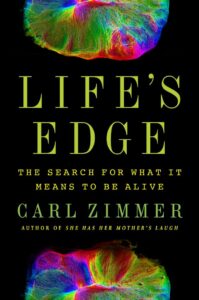The pandemic continues, but let me kick off this edition of Friday’s Elk by sharing some personal good news. My next book has a cover!

One of the long-running threads in my career as a writer has been a fascination about the fundamental nature of life. What does it mean to be alive? Is there even such a thing as life? Each of us knows what life is from the inside, but how can we turn that intuition into science? For my new book, Life’s Edge, I explored the border zones of life, where it becomes clear how much we have to learn. The book features Covid-19, tardigrades on the moon, hungry pythons, and much more.
The book won’t be coming out till March 2021. But you can already pre-order your copy. (There’s also an audio book available for pre-order.)
I’ve said it before and I’ll say it again: pre-ordering a book is one of the best ways to support an author. You’re not just buying a copy of the book itself. Lots of people in the book world keep tabs on pre-order numbers. Good numbers build buzz, and buzz will draw more attention to a book when it publishes.
Right now, March 2021 feels like centuries hence. Let’s hope that it’s an improvement on July 2020, when more than 128,000 people have died of Covid-19 in the United States alone. Here in the northeastern United States we are currently experiencing unsettling calm. Connecticut reached a peak of Covid-19 cases in April, with 2,109 people testing positive in just one day. But then the cases started to gradually fall. On July 3 Connecticut only had 71 new cases. So far, 4,326 people have died in our state, but over the past week the daily death count hasn’t risen above the single digits.
Elsewhere in this country, however, the virus is raging. In Arizona, California, Florida, and Texas–places that seemed to dodge the northeast’s devastation–new cases are climbing steeply every day. The climb far outstrips the increase in testing, indicating that this is a real outbreak and not a statistical artifact. The rise in hospitalizations tells the same heart-breaking story.
This surge has not yet led to a surge in deaths; in fact the daily death rate across the country has fallen from over 2,300 in April to 722 on July 2. That may be the result of younger people getting infected these days while older people–who are more likely to die–are taking better precautions. It may also be the result of American hospitals getting better at fighting this new virus, using new combinations of drugs and abandoning old treatments that worked for more familiar diseases. But another factor is the lag of several weeks between surges in cases and surges in deaths. It can take a while for this virus to kill. And so the death rate will almost certainly rise again this month.
Even if it doesn’t, that’s hardly cause for wild celebrations. Europe has crushed its curve, while we have failed. Tens of thousands of deaths so far were almost certainly preventable. And it’s also becoming clear that surviving Covid-19 is not like bouncing back from a cold. For some people, it leaves enduring damage, whether lung scars, heart damage, strokes, enduring fatigue, or diabetes. Since we’re only a few months into this pandemic we don’t yet understand extent of these impacts, but it would be grotesque to sweep them away in false optimism.
Right now, I worry that peaceful places like Connecticut are getting complacent. This virus can be particularly devious, spreading even before people show symptoms. And one infected person can, in the right place, infect dozens of others. Last week I wrote about what scientists are learning about these superspreading events, and how we might use that knowledge to fight the virus without having to go into blanket lockdowns.
On a brighter note, I worked with some of my Times colleagues this month to track the many efforts going on worldwide to make a vaccine for Covid-19. We started with 20 projects–all the clinical trials that had already started, plus some of the promising efforts that have not yet led to tests on people. Less than a month has passed since the tracker launched, but we’ve added ten more vaccines now in clinical trials, including ones being tested in Japan, India, and other countries. We will keep updating it with progress (and failure) until this race is done.
Finally, here’s a video of a conversation I had recently with Scientific American editor-in-chief Laura Helmuth about science writing in the age of Covid-19. I hope you enjoy it. Someday I look forward to giving talks in person, but Zoom will have to do for now.
That’s all for now. Stay safe!
My award-winning book, She Has Her Mother’s Laugh, is available in paperback. You can order it now from fine book mongers, including Amazon, Barnes and Noble, BAM, Hudson Booksellers, and IndieBound.
You can find information and ordering links for my 13 books here. You can also follow me on Twitter, Facebook, Goodreads, and LinkedIn. If someone forwarded this email to you, you can subscribe to it here.
Best wishes, Carl
Originally published July 3, 2020. Copyright 2020 Carl Zimmer.